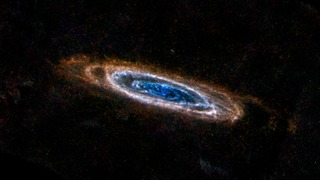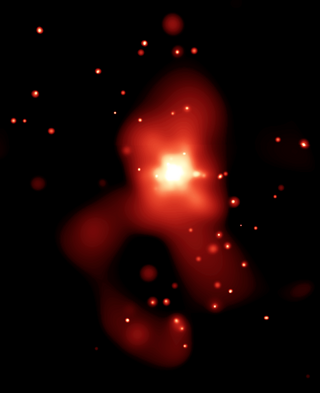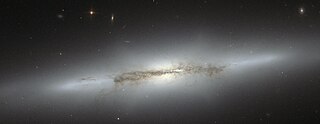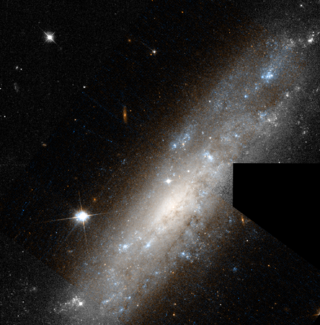Related Research Articles

The Andromeda Galaxy is a barred spiral galaxy and is the nearest major galaxy to the Milky Way. It was originally named the Andromeda Nebula and is cataloged as Messier 31, M31, and NGC 224. Andromeda has a D25 isophotal diameter of about 46.56 kiloparsecs (152,000 light-years) and is approximately 765 kpc (2.5 million light-years) from Earth. The galaxy's name stems from the area of Earth's sky in which it appears, the constellation of Andromeda, which itself is named after the princess who was the wife of Perseus in Greek mythology.

Far-infrared astronomy is the branch of astronomy and astrophysics that deals with objects visible in far-infrared radiation.

Centaurus A is a galaxy in the constellation of Centaurus. It was discovered in 1826 by Scottish astronomer James Dunlop from his home in Parramatta, in New South Wales, Australia. There is considerable debate in the literature regarding the galaxy's fundamental properties such as its Hubble type and distance. NGC 5128 is one of the closest radio galaxies to Earth, so its active galactic nucleus has been extensively studied by professional astronomers. The galaxy is also the fifth-brightest in the sky, making it an ideal amateur astronomy target. It is only visible from the southern hemisphere and low northern latitudes.

Messier 110, or M110, also known as NGC 205, is a dwarf elliptical galaxy that is a satellite of the Andromeda Galaxy in the Local Group.

NGC 6946, sometimes referred to as the Fireworks Galaxy, is a face-on intermediate spiral galaxy with a small bright nucleus, whose location in the sky straddles the boundary between the northern constellations of Cepheus and Cygnus. Its distance from Earth is about 25.2 million light-years or 7.72 megaparsecs, similar to the distance of M101 in the constellation Ursa Major. Both were once considered to be part of the Local Group, but are now known to be among the dozen bright spiral galaxies near the Milky Way but beyond the confines of the Local Group. NGC 6946 lies within the Virgo Supercluster.

The Herschel Space Observatory was a space observatory built and operated by the European Space Agency (ESA). It was active from 2009 to 2013, and was the largest infrared telescope ever launched until the launch of the James Webb Space Telescope in 2021. Herschel carries a 3.5-metre (11.5 ft) mirror and instruments sensitive to the far infrared and submillimetre wavebands (55–672 μm). Herschel was the fourth and final cornerstone mission in the Horizon 2000 programme, following SOHO/Cluster II, XMM-Newton and Rosetta.

NGC 2787 is a barred lenticular galaxy approximately 24 million light-years away in the northern constellation of Ursa Major. It was discovered on December 3, 1788 by German-born astronomer William Herschel. J. L. E. Dreyer described it as, "bright, pretty large, a little extended 90°, much brighter middle, mottled but not resolved, very small (faint) star involved to the southeast". The visible galaxy has an angular size of 2.5 × 1.5 arcminutes or 3.24 × 1.81 arcminutes and an apparent visual magnitude of 11.8.

NGC 278 is an isolated spiral galaxy in the northern circumpolar constellation of Cassiopeia, near the southern constellation boundary with Andromeda. It lies at a distance of approximately 39 megalight-years from the Milky Way, giving it a physical scale of 190 ly (58 pc) per arcsecond. The galaxy was discovered on December 11, 1786 by German-born astronomer William Herschel. J. L. E. Dreyer described it as, "considerably bright, pretty large, round, 2 stars of 10th magnitude near".

NGC 4194, the Medusa merger, is a galaxy merger in the constellation Ursa Major about 128 million light-years (39.1 Mpc) away. It was discovered on April 2, 1791 by German-British astronomer William Herschel. Due to its disturbed appearance, it is object 160 in Halton Arp's 1966 Atlas of Peculiar Galaxies.

NGC 4261 is an elliptical galaxy located around 100 million light-years away in the constellation Virgo. It was discovered April 13, 1784, by the German-born astronomer William Herschel. The galaxy is a member of its own somewhat meager galaxy group known as the NGC 4261 group, which is part of the Virgo Cluster.

NGC 4639 is a barred spiral galaxy located in the equatorial constellation of Virgo. It was discovered by German-born astronomer William Herschel on April 12, 1784. John L. E. Dreyer described it as "pretty bright, small, extended, mottled but not resolved, 12th magnitude star 1 arcmin to southeast". This is a relatively nearby galaxy, lying approximately 72 million light-years away from the Milky Way. It is a companion to NGC 4654, and the two appear to have interacted roughly 500 million years ago. NGC 4639 is a member of the Virgo Cluster.

NGC 4710 is an edge-on lenticular galaxy in the northern constellation of Coma Berenices. It was discovered on March 21, 1784 by German-British astronomer William Herschel. This galaxy has a B-band visual magnitude of 11.60 and an angular size of 3.0′ × 0.8′. It is located at a distance of 54.5 ± 3.6 million light-years (16.7 ± 1.1 Mpc) from the Milky Way, and is receding with a heliocentric radial velocity of 1,129 km/s. This is a member of the Virgo Cluster, with a projected offset of ~6° from the cluster center and a cluster crossing time of around two billion years.

NGC 4666 is a spiral galaxy in the equatorial constellation of Virgo, located at a distance of approximately 55 megalight-years from the Milky Way. It was discovered by the German-born astronomer William Herschel on February 22, 1784. It is a member of the Virgo II Groups, a series of galaxies and galaxy clusters strung out from the southern edge of the Virgo Supercluster. John L. E. Dreyer described it as "bright, very large, much extended 45°±, pretty suddenly brighter middle". It is a member of an interacting system with NGC 4668 and a dwarf galaxy, and belongs to a small group that also includes NGC 4632.

NGC 4030 is a grand design spiral galaxy located about 64 million light years away in the constellation Virgo. It is a member of the NGC 4030 Group of galaxies, which is a member of the Virgo II Groups, a series of galaxies and galaxy clusters strung out from the southern edge of the Virgo Supercluster. With an apparent visual magnitude of 10.6, it is visible with a small telescope as a 3 arc minute wide feature about 4.75° to the southeast of the star Beta Virginis. It is inclined by an angle of 47.1° to the line of sight from the Earth and is receding at a velocity of 1,465 km/s.

NGC 4102 is an intermediate barred spiral galaxy located in the northern constellation of Ursa Major. It is visible in a small telescope and has an apparent visual magnitude of 11.2. The galaxy was discovered April 12, 1789 by William Herschel. J. L. E. Dreyer described it as "bright, pretty small, round, brighter middle and bright nucleus". This galaxy is located at a distance of 60 million light years and is receding with a heliocentric radial velocity of 837 km/s. It is a member of the Ursa Major group of galaxies.

NGC 151 is a mid-sized barred spiral galaxy located in the constellation Cetus.

NGC 1003 is a spiral galaxy at the western edge of the Perseus constellation. It is located at a distance of about 36 million light years from the Milky Way and is receding with a heliocentric radial velocity of 624 km/s. This galaxy was discovered by the Anglo-German astronomer William Herschel on October 6, 1784, who described it as "pretty faint, large, extended 90°±, much brighter middle, mottled but not resolved". It is a member of the NGC 1023 group of galaxies.

NGC 4302 is an edge-on spiral galaxy located about 55 million light-years away in the constellation Coma Berenices. It was discovered by astronomer William Herschel on April 8, 1784 and is a member of the Virgo Cluster.

NGC 1325 is a flocculent spiral galaxy situated in the constellation of Eridanus. Located about 75 million light years away, it is a member of the Eridanus cluster of galaxies, a cluster of about 200 galaxies. It was discovered by William Herschel on 19 December 1799.

NGC 5273 is a lenticular galaxy located 54 million light-years away in the northern constellation of Canes Venatici. This galaxy was discovered by William Herschel on May 1, 1785. It is positioned 1+1⁄4° to the southeast of the star 25 Canum Venaticorum.
References
- Footnotes
- ↑ "Professor Stephen Eales - People". Cardiff University. Retrieved 15 October 2019.
- 1 2 Eales, S.; Dunne, L.; et al. (16 May 2010). "The Herschel ATLAS" (PDF). Publications of the Astronomical Society of the Pacific. 122 (891): 499. arXiv: 0910.4279 . Bibcode:2010PASP..122..499E. doi:10.1086/653086. S2CID 18852169.
- ↑ "Cardiff uni astronomers honoured". BBC News. 9 January 2015.
- ↑ "Stephen Eales" . Retrieved 15 October 2019.
- ↑ Eales, Stephen (16 August 2004). "Smoking Supernovae and Dusty Galaxies". S&T. 108 (2): 36. Bibcode:2004S&T...108b..36E.
- ↑ Eales, S.; Gear, W. (16 June 1997). "The final frontier. Introduction". AsNow. 11 (6): 41–44. Bibcode:1997AsNow..11...41E.
- ↑ Eales, Steve (2013). "Cool dust and baby stars". Physics World. 26 (1): 30–33. Bibcode:2013PhyW...26a..30E. doi:10.1088/2058-7058/26/01/32.
- ↑ Valiante, E.; Smith, M. W. L.; et al. (16 November 2016). "The Herschel-ATLAS data release 1 - I. Maps, catalogues and number counts" (PDF). MNRAS. 462 (3): 3146–3179. arXiv: 1606.09615 . Bibcode:2016MNRAS.462.3146V. doi: 10.1093/mnras/stw1806 .
- ↑ Eales, Stephen; Smith, Dan; et al. (16 January 2018). "The new galaxy evolution paradigm revealed by the Herschel surveys". MNRAS. 473 (3): 3507–3524. arXiv: 1710.01314 . Bibcode:2018MNRAS.473.3507E. doi: 10.1093/mnras/stx2548 . hdl: 1959.3/440785 .
- ↑ Pilbratt, G. L.; Riedinger, J. R.; et al. (16 July 2010). "Herschel Space Observatory. An ESA facility for far-infrared and submillimetre astronomy". Astronomy & Astrophysics. 518: L1. arXiv: 1005.5331 . Bibcode:2010A&A...518L...1P. doi:10.1051/0004-6361/201014759. S2CID 118533433.
- Sources
- Winners of RAS medals in 2015
- Smoking Supernovae and Dusty Galaxies, Sky and Telescope 2004
- The Final Frontier, Astronomy Now, 1997, Vol. 11, No. 6, p. 41
- Cool dust and baby stars, Physics World, Volume 26, 1
- Pilbratt, G. et al. 2010, Herschel Space Observatory – an ESA facility for far-infrared and submillimetre astronomy, Astronomy and Astrophysics, 518, L1